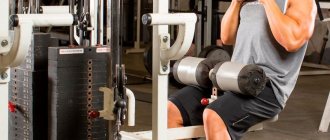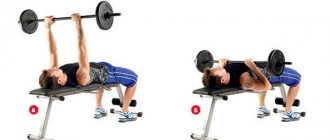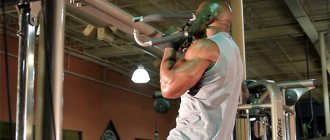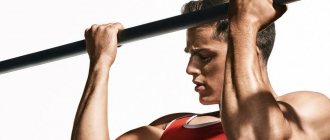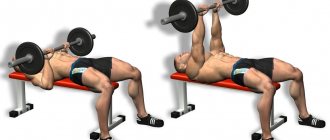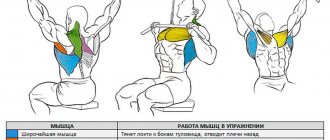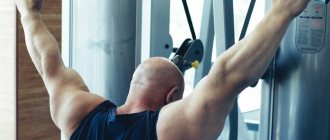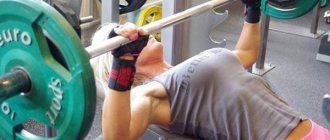Doing pull-ups with a narrow grip is important for developing not only the back muscles, but also the biceps of the arms. This movement allows you to harmoniously develop the entire muscle mass of the back, and not put an axial load on the spine. The exercise will also help those who want to have impressive arms, but do not like bodybuilding workouts with a dozen different movements for the biceps. This exercise is good for compensating for the axial load on the spine that we experience when squatting with a barbell on the back or chest, as well as performing snatches, jerks and jumping movements. Pull-ups appear first for a teenager, because they do not affect growth points in any way, and allow the young body to become stronger without harming itself. They should also be performed by fitness athletes, because they allow them to overcome a set of problems called “office posture.”
The essence of the exercise and its benefits
Why is it not enough to only do pull-ups with a wide grip? Bodybuilding sources believe that the wider the grip, the more the latissimus and teres muscles work. Pumping them up helps to acquire that very “inverted triangle” look that gym visitors strive for. And if you do pull-ups with a narrow grip, part of the load is taken by the biceps and rhomboid muscles of the back. This allows you to pump up the so-called depth, that is, make the muscles thicker.
It turns out that both options are needed for aesthetics. Those who value health should know that a close grip in a pull-up allows you to balance the shoulder abductors and pectoral muscles. An athlete who pulls up with both a medium and close grip can easily keep his shoulders turned and not slouch.
The close-grip pull-up is the “key to athletic arms” that many are looking for when performing a million concentrated biceps curls in one workout.
The benefits of close grip pull-ups
The key to arm and back strength is performing the exercise with a large range of motion. So, pull-ups with a medium and narrow grip are a back exercise with the largest working amplitude. It allows you not only to develop “muscle thickness”, but also to significantly increase strength indicators. The movement is suitable for those who have problems with the standing press and pushes, as well as problems with regular pull-ups. Increasing your results in pull-ups with a medium and narrow grip will allow you to do more biceps lifts too.
This is one of the exercises that should be included in training if a person is actively pumping the chest or bench pressing for strength results. Pull-ups with a close grip help compensate for muscle work. This is important for preventing injuries to the elbow and shoulder joints and maintaining good posture.
Contraindications
It is believed that pull-ups are ideal for postural disorders, scoliosis, kyphosis and hyperlordosis. But that's not true. Many people, in addition to hernia curvatures, also have various compensatory changes in the shoulder joints. If one shoulder is lower than the other, there are postural problems and similar problems, you should definitely consult a doctor so as not to aggravate your condition.
Those who have protrusions and hernias should not be pulled up during an exacerbation. Also, the doctor must decide which technique is optimal for the patient to work with, since kipping and butterfly, as well as minimal assistance with the legs, create a load on the spine.
You will have to give up pull-ups for a while if you cannot heal injuries to ligaments and joints, as well as inflammatory processes in the muscles. Beginners should not use plans like "100 pull-ups" to avoid overtraining and causing harm to themselves.
A contraindication is also the exacerbation of diseases associated with loss of orientation in space - epilepsy, disorders of the central nervous system. You should pull yourself up carefully if the weight is heavy and your grip does not hold. In this case, straps are used.
Close grip pull-ups. Correct technique for performing the exercise. Training video
Determining your fitness level
Before you start training, you need to determine your maximum pull-up level. To do this, you need to pull yourself up as many times as possible in one approach.
If you pulled yourself up on the horizontal bar 1-2 times, then in the first two weeks you need to use a bench . Stand on the bench, holding the horizontal bar and fixing your body at the top point, touching the bar with your chin. Perform the lowering slowly, feel how each muscle tenses. Do 3 sets of 5 repetitions at this pace. The lowering time should be 5 – 10 seconds.
Those who can do more than two pull-ups should do more sets but fewer reps. Rest between repetitions should be no more than two minutes.
If you belong to those categories of people who can do 5-10 pull-ups, then you have enough strength, but you need to develop endurance. For each approach, you need to perform the maximum number of repetitions, in 3-4 approaches. In any case, don’t try to squeeze the maximum out of yourself right away. The load must be increased gradually .
Highest level. This category includes those who can pull themselves up on the bar 10 or more times in one approach. If you show such a high result on the horizontal bar, it means you are strong and trained enough. Therefore, it is recommended to use additional weight to achieve better results. This weight will reduce the number of repetitions and add strength.
What muscles work
The main working muscles here are slightly different from the classic version, when the main mover is the broadest:
- The pull-up starts using the biceps of the arms;
- Further included are diamond-shaped, large and small round and trapezoidal;
- The final phase of the movement also connects the muscles of the forearm;
- The lats are involved in the work to a lesser extent
The spinal extensors, abs, hips and buttocks work as stabilizers.
What prevents you from learning how to do pull-ups?
Pull-ups on the horizontal bar (the program from scratch will help you quickly master the exercise) require regularity and patience. But many beginners give up very quickly, without even learning how to do anything properly.
What exactly prevents you from doing regular workouts? There are several negative factors:
- Very weak muscles. Exercise yourself regularly, developing strength and endurance.
- Excess weight. Even a few kilograms is a huge obstacle to doing pull-ups. In this case, trainers recommend first losing weight and only then starting the horizontal bar. Although simplified versions (for example, gravitron) are not canceled.
- Perhaps you have well-developed muscles necessary for pull-ups, but you still can’t do the exercise. In this case, pay attention to the auxiliary muscles. You may have weak deltoid and radial muscles, as well as weak hands. In this case, strengthen them first. In general, pay attention to all muscles. Only harmonious development will be the key to proper pull-ups.
- Incorrect pull-up technique on the horizontal bar. Watch a video or consult a trainer before attempting it. After all, if you have the wrong technique, you simply won’t be able to pull yourself up.
Narrow parallel grip pull-up
There are two types of narrow parallel grip - on the V-shaped handle, and on the width of the athlete's shoulders. The second is technically average, but it is also called narrow in articles and sports training videos.
Bar pull-ups involve the biceps and teres major and minor muscles more than the lats. They are used for “shaping” and as an auxiliary exercise for the bench press. Typically, this option is performed with a reduced amplitude, without fully straightening the arms, simply because this option with straightening is uncomfortable for the shoulders and elbows. This movement is used to dynamically develop the deflection in the thoracic region and bring the shoulder blades together, so you need to control the position of the spine.
Pull-ups with a narrow parallel grip: execution technique
Where should you start?
Pull-ups on the horizontal bar (a program from scratch is the key to your success) require a special technique for different levels of training. If you don’t know how to lift your weight at all, then try this technique. Take a position as if you had already pulled yourself up and hold for a few seconds. Now slowly straighten your arms and just hang on the bar. Do this exercise several times every day. In just a couple of weeks you will be able to fully tighten up.
In many gyms there is an excellent simulator - a gravitron. It is designed specifically for beginners. Whatever your fitness level, you can master pull-ups. Set the difficulty level that's right for you. And start pulling yourself up. But be careful not to make it too easy. Otherwise there will be no effect.
Straight-grip pull-up
For many people, this is the most difficult option, because they simply anatomically cannot seriously use their back, and pull themselves up with only their arms and forearms. The secret of this movement is to create a deflection in the thoracic region so that the back muscles seem to push the body upward.
This movement works well on the teres muscle mass if performed with a bend. But if shoulder mobility is impaired, it should not be performed. If an athlete cannot move his forearm behind his ear in a calm state, he should not do this version of the exercise, because he may get injured due to limited movement. In case of limited mobility, it is worth starting with a wider grip, compensating for some of the body weight if necessary.
When to use weights
In sports, weights are used for intense muscle growth and better training. Such devices force all muscle groups to act, thereby stimulating endurance, increasing a person’s strength and burning the amount of fatty tissue. As a result of pull-ups with weights, muscle tissue develops harmoniously.
However, the loads should be gentle to provide the muscles involved with moderate tension during movement.
These attributes will be very useful:
- people after 35 years of age, when natural processes occur in the body aimed at reducing muscle mass;
- those who want to lose extra pounds;
- those who want to quickly turn their backs and arms into a pile of muscles.
Before training with weights, you should definitely warm up, since the body must be warmed up.
For the first time, it is better to limit the additional weight to no more than 1 kg. The number of repetitions of the exercise should be increased gradually. If today you did 25 pull-ups with a weight, then tomorrow do it 28-30 times. Important! The aggravating weight should be increased only after 4–5 workouts.
The use of weights is strictly prohibited when:
- varicose veins and other diseases of the cardiovascular system (including high blood pressure);
- gallstone and urolithiasis;
- diseases of the digestive system;
- failures of the respiratory system;
- undergone operations (the ban is valid for 12 months);
- fractures, dislocations, bruises.
Close-grip pull-up
This is a classic movement that helps target your biceps. The exercise not only helps develop arm strength, but also helps strengthen the ligaments of the elbow joint. At the start, it is recommended to hang on fully extended arms, but do not “insert” your elbows, that is, do not push back with force. Movement helps make biceps more developed, even if a person genetically does not have peaks and has little mass in these muscles.
Pull-ups with a narrow reverse grip can be uncomfortable with sore elbows, for example, for those who bench press, then it is changed to pull-ups with a medium parallel grip.
It's REVERSE GRIP PULL-UPS, baby!
Such different pull-ups...
But first, let’s make an important note: which muscles will work during the exercise directly depends on the type of grip chosen by the athlete. Thus, with just one exercise (but in different variations) you can train different muscle groups and ligaments. Comprehensive muscle development contributes to a rapid increase in strength, muscle mass, endurance and other athletic performance. In addition, it provides a powerful anabolic boost to the body.
Common mistakes
Load displacement . This is one of the most common mistakes athletes make when performing pull-ups. Often, beginners set themselves the task of doing pull-ups a certain number of times, but do not pay attention to technique. Because of this, some muscle group gets more tired, and the exercise loses its normal amplitude. This leads to a shift in the load received by the muscles, so the athlete cannot complete the exercise efficiently.
Pull-up speed . Beginners mistakenly believe that they need to try to complete given repetitions in the shortest possible time. The fact is that muscles do not know how to count repetitions, since they perceive the load solely in terms of time. If you're doing pull-ups at a fast pace, it's important to do as many reps as possible, so don't set yourself a fixed number of pull-ups.
Weak control of the negative phase . The negative phase of the pull-up begins the moment the athlete lowers his body down. Very often you can see how professionals sharply “throw” it down with relaxed muscles. This should never be done, as you can damage your joints. In addition, the effectiveness of the exercise decreases.
The most effective fat burner is rightfully considered... Did you think it would be so easy to find out about it? Read in a separate article.
Try a chest press machine if you want to build up your chest muscles. More details on this page.
Correct technique
The pull-up technique on the horizontal bar includes several very important rules. They will be the key to proper training:
- The grip must be very strong. Grasp the horizontal bar as firmly and comfortably as possible.
- Perform the exercise only using your muscles. Do not jerk or push. Incorrect technique is not only ineffective, but also dangerous.
- Make the ascent and descent very smooth. The slower the better. Avoid jerking.
- With each repetition, the chin should be above the horizontal bar. Only in this way will the exercise be considered correctly performed.
- Don't lose your breath. Remember that on the way up you need to exhale, and on the way down, on the contrary, inhale.
- Pay attention to the body. During pull-ups, it should be in an upright position.
Tips for effective training
The pull-up chart will help you achieve your goal faster. Find a program online that you like best and stick to it every day. This way, you won’t feel sorry for yourself and will learn to pull yourself up faster. If you have chosen a program for people who do not know how to do pull-ups at all, then first, just hang on the horizontal bar for several weeks to strengthen your hands. If you want to increase endurance, make all the muscles of the upper body beautiful and strong, then use different grips.
Follow the diagram, but not completely. If you can't do five pull-ups as written in the program, then do as many as you can. And based on this result, make a table yourself. During your workout, listen to pleasant, motivating music. This way, you will improve your mood and your workout will be more effective. Try to pull yourself up correctly. The further result will depend on the technique with which you perform the exercise. And don’t be upset if something doesn’t work out for you. The main thing is to train regularly and do not forget about proper rest. And very soon you will become strong and resilient, and your muscles will receive the desired relief.
Pull-up table “30 times in 30 weeks”
Experts have developed a pull-up scheme that will allow even a person with poor training to perform thirty pull-ups in thirty weeks. But before you start this scheme, get rid of excess weight and strengthen the muscles throughout your body. Try to lift six days a week, taking one day off. It's best to rest on Sunday so you can start the next week on Monday.
